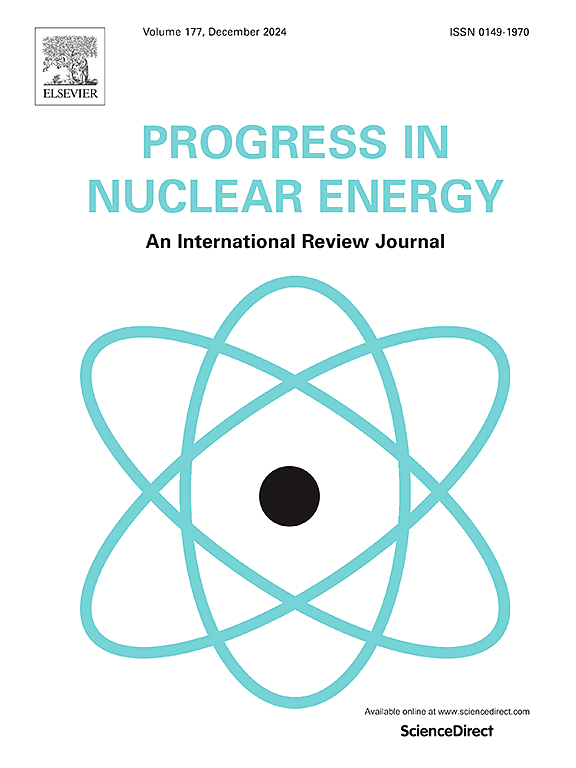Assessment of RELAP5/SCDAPSIM code against NACIE-UP facility tests
IF 3.2
3区 工程技术
Q1 NUCLEAR SCIENCE & TECHNOLOGY
引用次数: 0
Abstract
During the 2017 campaign, ADP10 and ADP06 tests were performed in NAtural Circulation Experiment – Upgraded (NACIE-UP) facility built at ENEA Brasimone Research Centre to analyze the behavior of the 19-pins wire-spaced fuel pin bundle simulator (FPS) during the transition from forced to natural circulation flow. Although the total heating power is the same in both tests, in the ADP10 test the power was uniformly distributed among the 19 electrically heated pins, whereas in the ADP06 test, only the 7 central pins were switched-on. The present paper presents the application of RELAP5/SCDAPSIM/MOD4.1 (RS4.1) code for ADP10 and ADP06 tests subchannel analysis. RELAP/SCDAPSIM code is a system code initially designed for the thermal-hydraulic and safety analysis of Light Water Reactors (LWRs). Over the years, the code has been extensively improved by incorporating additional fluid properties used as coolants for advanced reactors, among which molten lead, lead-bismuth eutectic (LBE) and molten salts. Although the RS4.1 is a system code the present paper describes the code capabilities in predicting the subchannels thermal behavior under the ADP10 and ADP06 test conditions from the NACIE-UP facility. RS4.1 simulations results for LBE mass flow rate and temperature measured by thermocouples showed good agreement with experimental data which indicates that RS4.1 code can be successfully employed as subchannel code.
根据nacieup设施测试评估RELAP5/SCDAPSIM代码
在2017年的活动中,ADP10和ADP06在ENEA Brasimone研究中心建造的自然循环实验升级(nacieup)设施中进行了测试,以分析19针线间距燃料针束模拟器(FPS)在从强制循环过渡到自然循环过程中的行为。虽然两个测试的总加热功率相同,但在ADP10测试中,功率均匀分布在19个电加热引脚上,而在ADP06测试中,只有7个中心引脚接通。本文介绍了应用RELAP5/SCDAPSIM/MOD4.1 (RS4.1)代码对ADP10和ADP06测试子信道进行分析。RELAP/SCDAPSIM代码是最初为轻水反应堆(LWRs)的热水力和安全分析设计的系统代码。多年来,该规范通过纳入用作先进反应堆冷却剂的其他流体特性,包括熔融铅、铅铋共晶(LBE)和熔盐,得到了广泛的改进。虽然RS4.1是一个系统代码,但本文描述了该代码在nacie - upfacility的ADP10和ADP06测试条件下预测子通道热行为的能力。RS4.1对热电偶测得的LBE质量流率和温度的仿真结果与实验数据吻合较好,表明RS4.1码可以成功地用作子信道码。
本文章由计算机程序翻译,如有差异,请以英文原文为准。
求助全文
约1分钟内获得全文
求助全文
来源期刊

Progress in Nuclear Energy
工程技术-核科学技术
CiteScore
5.30
自引率
14.80%
发文量
331
审稿时长
3.5 months
期刊介绍:
Progress in Nuclear Energy is an international review journal covering all aspects of nuclear science and engineering. In keeping with the maturity of nuclear power, articles on safety, siting and environmental problems are encouraged, as are those associated with economics and fuel management. However, basic physics and engineering will remain an important aspect of the editorial policy. Articles published are either of a review nature or present new material in more depth. They are aimed at researchers and technically-oriented managers working in the nuclear energy field.
Please note the following:
1) PNE seeks high quality research papers which are medium to long in length. Short research papers should be submitted to the journal Annals in Nuclear Energy.
2) PNE reserves the right to reject papers which are based solely on routine application of computer codes used to produce reactor designs or explain existing reactor phenomena. Such papers, although worthy, are best left as laboratory reports whereas Progress in Nuclear Energy seeks papers of originality, which are archival in nature, in the fields of mathematical and experimental nuclear technology, including fission, fusion (blanket physics, radiation damage), safety, materials aspects, economics, etc.
3) Review papers, which may occasionally be invited, are particularly sought by the journal in these fields.
 求助内容:
求助内容: 应助结果提醒方式:
应助结果提醒方式:


